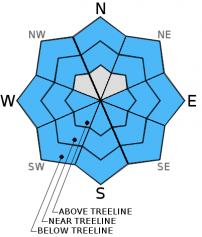| Saturday | Saturday Night | Sunday | |
|---|---|---|---|
| Weather: | Sunny with some clouds in the afternoon | Mostly clear with a few clouds after midnight | Sunny becoming partly cloudy |
| Temperatures: | 49 to 56 deg. F. | 26 to 33 deg. F. | 48 to 55 deg. F. |
| Mid Slope Winds: | Variable | Southwest | West |
| Wind Speed: | Light | 10 to 15 mph in the evening becoming light overnight | Light winds in the morning increasing to 10 to 15 mph with gusts to 25 mph in the afternoon |
| Expected snowfall: | 0 | 0 | 0 |
| Saturday | Saturday Night | Sunday | |
|---|---|---|---|
| Weather: | Sunny with some clouds in the afternoon | Mostly clear with a few clouds after midnight | Sunny becoming partly cloudy |
| Temperatures: | 44 to 51 deg. F. | 25 to 32 deg. F. | 43 to 50 deg. F. |
| Ridge Top Winds: | Southwest | Southwest | Southwest |
| Wind Speed: | 10 to 15 mph | 10 to 15 mph with gusts to 25 mph in the evening | 15 to 20 mph with gusts to 30 mph |
| Expected snowfall: | 0 | 0 | 0 |























